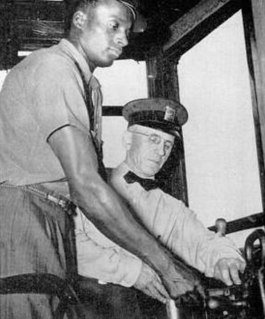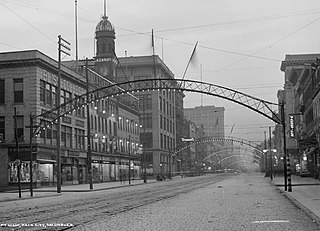
The Amalgamated Transit Union (ATU) is a labor organization in the United States and Canada that represents employees in the public transit industry. Established in 1892 as the Amalgamated Association of Street Railway Employees of America, the union was centered primarily in the Eastern United States; today, ATU has over 200,000 members throughout the United States and Canada.

Transport Workers Union of America (TWU) is a United States labor union that was founded in 1934 by subway workers in New York City, then expanded to represent transit employees in other cities, primarily in the eastern U.S. This article discusses the parent union and its largest local, Local 100, which represents the transport workers of New York City. TWU is a member of the AFL-CIO.

The Great Railroad Strike of 1877, sometimes referred to as the Great Upheaval, began on July 14 in Martinsburg, West Virginia, after the Baltimore and Ohio Railroad (B&O) cut wages for the third time in a year. This strike finally ended some 69 days later, after it was put down by unofficial militias, the National Guard, and federal troops. Because of economic problems and pressure on wages by the railroads, workers in numerous other cities, in New York, Pennsylvania and Maryland, into Illinois and Missouri, also went out on strike. An estimated 100 people were killed in the unrest across the country. In Martinsburg, Pittsburgh, Philadelphia and other cities, workers burned down and destroyed both physical facilities and the rolling stock of the railroads—engines and railroad cars. Local populations feared that workers were rising in revolution such as the Paris Commune of 1871.
The Westmoreland County coal strike of 1910–1911, or the Westmoreland coal miners' strike, was a strike by coal miners represented by the United Mine Workers of America. The strike is also known as the Slovak Strike because about 70 percent of the miners were Slovak immigrants. It began in Westmoreland County, Pennsylvania, on March 9, 1910, and ended on July 1, 1911. At its height, the strike encompassed 65 mines and 15,000 coal miners. Sixteen people were killed during the strike, nearly all of them striking miners or members of their families. The strike ended in defeat for the union.
The Remington Rand strike of 1936–1937 was a strike by a federal union affiliated with the American Federation of Labor (AFL) against the Remington Rand company. The strike began in May 1936 and ended in April 1937, although the strike settlement would not be fully implemented until mid-1940.

The General Strike of 1910 was a labor strike by trolley workers of the Philadelphia Rapid Transit Company that grew to a citywide riot and general strike in Philadelphia, Pennsylvania.
The Omaha Traction Company was a privately owned public transportation business in Omaha, Nebraska. Created in the early 1900s by wealthy Omaha banker Gurdon Wattles, the company was involved in a series of contentious disputes with organized labor.

The Indianapolis streetcar strike of 1913 and the subsequent police mutiny and riots was a breakdown in public order in Indianapolis, Indiana. The events began as a workers strike by the union employees of the Indianapolis Traction & Terminal Company and their allies on Halloween night, October 31, 1913. The company was responsible for public transportation in Indianapolis, the capital city and transportation hub of the U.S. state of Indiana. The unionization effort was being organized by the Amalgamated Street Railway Employees of America who had successfully enforced strikes in other major United States cities. Company management suppressed the initial attempt by some of its employees to unionize and rejected an offer of mediation by the United States Department of Labor, which led to a rapid rise in tensions, and ultimately the strike. Government response to the strike was politically charged, as the strike began during the week leading up to public elections. The strike effectively shut down mass transit in the city and caused severe interruptions of statewide rail transportation and the 1913 city elections.

The Philadelphia transit strike of 1944 was a sickout strike by white transit workers in Philadelphia that lasted from August 1 to August 6, 1944. The strike was triggered by the decision of the Philadelphia Transportation Company (PTC), made under prolonged pressure from the federal government in view of significant wartime labor shortages, to allow black employees of the PTC to hold non-menial jobs, such as motormen and conductors, that were previously reserved for white workers only. On August 1, 1944, the eight black employees being trained as streetcar motormen were due to make their first trial run. That caused the white PTC workers to start a massive sickout strike.

The St. Louis streetcar strike of 1900 was a labor action, and resulting civil disruption, against the St. Louis Transit Company by a group of three thousand workers unionized by the Amalgamated Street Railway Employees of America.

From 1895 to 1929, streetcar strikes affected almost every major city in the United States. Sometimes lasting only a few days, these strikes were often "marked by almost continuous and often spectacular violent conflict," at times amounting to prolonged riots and weeks of civil insurrection.

William Daniel Mahon (1861–1949) was a former coal miner and streetcar driver who became president of the Amalgamated Association of Street Railway Employees of America, now the Amalgamated Transit Union.

The 1877 St. Louis general strike was one of the first general strikes in the United States. It grew out of the Great Railroad Strike of 1877. The strike was largely organized by the Knights of Labor and the Marxist-leaning Workingmen's Party, the main radical political party of the era.

The Los Angeles streetcar strike of 1919 was the most violent revolt against the open-shop policies of the Pacific Electric Railway Company in Los Angeles. Labor organizers had fought for over a decade to increase wages, decrease work hours, and legalize unions for streetcar workers of the Los Angeles basin. After having been denied unionization rights and changes in work policies by the National War Labor Board, streetcar workers broke out in massive protest before being subdued by local armed police force.

The Denver streetcar strike of 1920 was a labor action and series of urban riots in downtown Denver, Colorado, beginning on August 1, 1920, and lasting six days. Seven were killed and 50 were seriously injured in clashes among striking streetcar workers, strike-breakers, local police, federal troops and the public. This was the "largest and most violent labor dispute involving transportation workers and federal troops".
The Saint John street railway strike of 1914 was a strike by workers on the street railway system in Saint John, New Brunswick, Canada, which lasted from 22–24 July 1914, with rioting by Saint John inhabitants occurring on 23 and 24 July. The strike shattered the image of Saint John as a conservative town dominated primarily by ethnic and religious divisions, and highlighting tensions between railway industrialists and the local working population.
Columbus, the capital city of Ohio, was founded on the east bank of the Scioto River in 1812. The city was founded as its capitol, beside the town of Franklinton, since incorporated into Columbus. The city's early history was gradual, as residents dealt with flooding and cholera epidemics, and the city had few direct connections to other cities. This led creation of a feeder canal, and later, freight and passenger railroads. The city became known for its industry and commercial businesses into the 20th century, though it experienced a lull in development in the late 20th century. In the 21st century, Columbus has been increasingly revitalized, led by parks projects, new developments, and efforts to beautify individual neighborhoods.

Public transit has taken numerous forms in Columbus, the largest city and capital of Ohio. Transit has variously used passenger trains, horsecars, streetcars, interurbans, trolley coaches, and buses. Current service is through the Central Ohio Transit Authority's bus system, numerous intercity bus companies, and through bikeshare, rideshare, and electric scooter services.
The Atlanta streetcar strike of 1916 was a labor strike involving streetcar operators for the Georgia Railway and Power Company in Atlanta, Georgia. Precipitated by previous strike action by linemen of Georgia Railway earlier that year, the strike began on September 30 and ended January 5 of the following year. The main goals of the strike included increased pay, shorter working hours, and union recognition. The strike ended with the operators receiving a wage increase, and subsequent strike action the following year lead to union recognition.

Columbus, Ohio has a legacy of using wooden and metal arches on its urban streets. Initially installed in 1888 for lighting during a national Grand Army of the Republic convention, the arches or more permanent replacements were placed on city streets until around 1914, used as overhead lines for electric streetcar wires, until more conventional poles became more favorable. Modern-day arches were installed in the city's Short North neighborhood in 2002, in an effort to unify the district, draw visitors, and increase business sales.

















